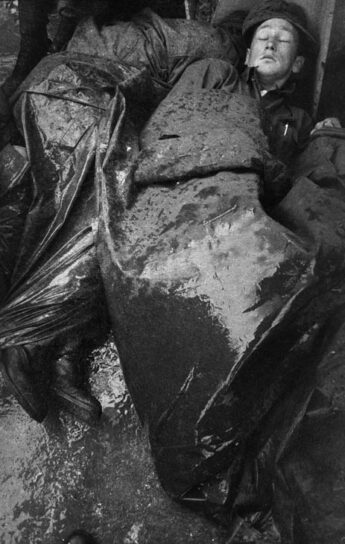Different kinds of war: Reflections on Memorial Day 2020

As I looked through Harold’s Draftee series for some appropriate photographs to share on this 2020 Memorial Day observance, the irony of the one above did not escape me. This GI is getting inoculated in both arms as a way to prepare for the war overseas. Harold went off to Korea in 1952. Approximately 35,000 GIs died from that war in three years. At this writing, the U.S. deaths from Covid-19 hit 100,000, after approximately four months. It’s a different kind of war, and at this writing there’s no inoculation from it. Hopefully before too long. Perhaps one day there will be a special memorial day set aside for the lives lost from this battle.

A headline in today’s New York Times states “They survived the worst of World War II. And Died of the Virus.” It recounts the harrowing stories of James Leach Miller, 96, Emilio DiPalma, 94 and Sam Lococo, 94, all of whom lived at The Holyoke Soldiers Home in Massachusetts and died in the past two months. Miller had survived the D-Day landing on Omaha Beach. DiPalma, at 19, guarded Hermann Goering during the Nuremberg Trials in 1945 . Lococo helped to rescue Japanese kamikaze pilots who crashed in the Pacific. All three saw the worst of war, yet in the end the virus — and negligence — killed them. It’s hard not to be a little cynical about the lofty words we use in memorializing and praising the service and sacrifices of our veterans when stories like these reveal the duplicities that lurk in the shadows of our frayed social contract.
Of the 210 veterans who were living in the facility in late March, 89 are now dead, 74 having tested positive for the virus. Almost three-quarters of the veterans inside were infected. It is one of the highest death tolls of any end-of-life facility in the country.
Alas, stories like The Holyoke Soldiers Home have been repeated throughout the country. On May 10, the New York Times reported on the horrific case of the New Jersey Veterans Home in Paramus, New Jersey where a full 60% of the residents were infected at that time, and 74 had already died. Of the remaining 209, fully 133 had tested positive. As journalist Tracey Tully put it:
“The home is built on the idea that those who served in the military are entitled to dignified care in their twilight years. “
Tully rightly described the outbreak at the Veterans Home in Paramus a betrayal of this fundamental pact.


Some have described service in the armed forces as “loaning your body” to the government. Whether America’s veterans have served their country out of passion for the cause or were conscripted, the consequences last a lifetime. We honor their sacrifices realizing that the pride they may hold is all too often mixed with scars not easily shared.
There are too many lessons to be learned from all this. And surely one of must come from the sobering picture emerging (though by no means new) of the often deplorable conditions inside nursing homes and veterans homes. There are all kinds of wars and way too many victims.
Dignity. Gratitude. Respect. These words get dusted off several times a year when it comes time for public remembrances. Let us work harder to internalize them and bring them into our vocabulary — and our actions — 365 days a year.

“…with firmness in the right as God gives us to see the right, let us strive on to finish the work we are in, to bind up the nation’s wounds, to care for him who shall have borne the battle and for his widow and his orphan.” Abraham Lincoln’s Second Inaugural Address, 1865.
Thank you Judith for sharing your passionate thoughts gracefully written partnered with Harold’s photos that always convey a pensive visual story. Your post inspired my conceptualizing on this day of remembrance. Unfortunately this 2020 Remembrance is juxtaposed with our present challenge to stay hopeful while remaining fully aware how the absence of leadership, in fact did tragically cause many veterans to die from an avoidable death.
I read& I read and looked&Looked& then…saw it was YOUR wonderful work …as I sit here in my Studio in the Mtns of Colorado writing to you and WEARING YOUR GLASSSES left here long ago..
.. . .safe travels with love,
Vicki Aisner Porter
